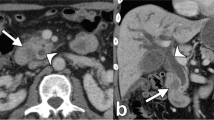Abstract
Purpose
To determine imaging findings of pancreatic adenocarcinomas incidentally detected on contrast-enhanced multiphasic dynamic computed tomography (CT) obtained during the follow-up for other diseases.
Methods
From January 2007 to December 2018, 14 patients with pancreatic adenocarcinomas incidentally detected on CT obtained during the follow-up for other diseases (incidental group) and 105 patients with pancreatic adenocarcinomas symptomatically detected on ultrasound or CT (non-incidental group) were included. Imaging characteristics of the tumor were compared between the two groups. Additionally, imaging findings prior to the detection of a tumor on previous CT images in the incidental group were also assessed.
Results
In cancers of the pancreas body/tail, there was a significantly smaller tumor size (median, 17 mm vs. 42 mm, p < 0.001), a significantly lower incidence of loss of fatty marbling (p = 0.025), vascular involvement (p < 0.001), lymph node metastasis (p = 0.046) and distant metastasis (p = 0.017), and a significantly higher incidence of preserved lobulation (p < 0.001) in the incidental group than in the non-incidental group. Regarding the cancers of the pancreas head, there were no significant differences in the radiological findings between the two groups. On previous CT images, small pancreatic nodules, secondary signs, and loss of fatty marbling tended to be the preceding findings of incidental pancreatic adenocarcinomas.
Conclusion
Incidentally detected pancreatic adenocarcinomas in the pancreas body/tail were characterized by an earlier tumor stage than in cases of symptomatically detected pancreatic adenocarcinoma. Several CT findings prior to the detection of a tumor may be useful for the early detection of pancreatic adenocarcinoma during the follow-up for other diseases.





Similar content being viewed by others
References
Bray F, Ferlay J, Soerjomataram I, Siegel RL, Torre LA, Jemal A (2018) Global cancer statistics 2018: GLOBOCAN estimates of incidence and mortality worldwide for 36 cancers in 185 countries. CA Cancer J Clin 68:394-424
Bosetti C, Bertuccio P, Negri E, La Vecchia C, Zeegers MP, Boffetta P (2012) Pancreatic cancer: overview of descriptive epidemiology. Mol Carcinog 51:3-13
Lambe M, Eloranta S, Wigertz A, Blomqvist P (2011) Pancreatic cancer; reporting and long-term survival in Sweden. Acta Oncol 50:1220-1227
Oberstein PE, Olive KP (2013) Pancreatic cancer: why is it so hard to treat? Therap Adv Gastroenterol 6:321-337
Egawa S, Takeda K, Fukuyama S, Motoi F, Sunamura M, Matsuno S (2004) Clinicopathological aspects of small pancreatic cancer. Pancreas 28:235-240
Lahat G, Ben Haim M, Nachmany I et al (2009) Pancreatic incidentalomas: high rate of potentially malignant tumors. J Am Coll Surg 209:313-319
Santo E, Bar-Yishay I (2017) Pancreatic solid incidentalomas. Endosc Ultrasound 6:S99-s103
Takeda Y, Saiura A, Takahashi Y et al (2017) Asymptomatic Pancreatic Cancer: Does Incidental Detection Impact Long-Term Outcomes? J Gastrointest Surg 21:1287-1295
Winter JM, Cameron JL, Lillemoe KD et al (2006) Periampullary and pancreatic incidentaloma: a single institution’s experience with an increasingly common diagnosis. Ann Surg 243:673-680; discussion 680-673
Ahn SS, Kim MJ, Choi JY, Hong HS, Chung YE, Lim JS (2009) Indicative findings of pancreatic cancer in prediagnostic CT. Eur Radiol 19:2448-2455
Yoon SH, Lee JM, Cho JY et al (2011) Small (</= 20 mm) pancreatic adenocarcinomas: analysis of enhancement patterns and secondary signs with multiphasic multidetector CT. Radiology 259:442-452
Gonoi W, Hayashi TY, Okuma H et al (2017) Development of pancreatic cancer is predictable well in advance using contrast-enhanced CT: a case-cohort study. Eur Radiol 27:4941-4950
Berland LL, Lawson TL, Foley WD, Greenen JE, Stewart ET (1981) Computed tomography of the normal and abnormal pancreatic duct: correlation with pancreatic ductography. Radiology 141:715-724
Karasawa E, Goldberg HI, Moss AA, Federle MP, London SS (1983) CT pancreatogram in carcinoma of the pancreas and chronic pancreatitis. Radiology 148:489-493
Tamada T, Ito K, Kanomata N et al (2016) Pancreatic adenocarcinomas without secondary signs on multiphasic multidetector CT: association with clinical and histopathologic features. Eur Radiol 26:646-655
Gilbeau JP, Poncelet V, Libon E, Derue G, Heller FR (1992) The density, contour, and thickness of the pancreas in diabetics: CT findings in 57 patients. AJR Am J Roentgenol 159:527-531
Hong SB, Lee SS, Kim JH et al (2018) Pancreatic Cancer CT: Prediction of Resectability according to NCCN Criteria. Radiology 289:710-718
Birchard KR, Semelka RC, Hyslop WB et al (2005) Suspected pancreatic cancer: evaluation by dynamic gadolinium-enhanced 3D gradient-echo MRI. AJR Am J Roentgenol 185:700-703
Takeshita K, Kutomi K, Haruyama T et al (2010) Imaging of early pancreatic cancer on multidetector row helical computed tomography. Br J Radiol 83:823-830
(1999) American gastroenterological association medical position statement: epidemiology, diagnosis, and treatment of pancreatic ductal adenocarcinoma. Gastroenterology 117:1463-1484
Kalser MH, Barkin J, MacIntyre JM (1985) Pancreatic cancer. Assessment of prognosis by clinical presentation. Cancer 56:397-402
Gangi S, Fletcher JG, Nathan MA et al (2004) Time interval between abnormalities seen on CT and the clinical diagnosis of pancreatic cancer: retrospective review of CT scans obtained before diagnosis. AJR Am J Roentgenol 182:897-903
Shen M, Boffetta P, Olsen JH et al (2006) A pooled analysis of second primary pancreatic cancer. Am J Epidemiol 163:502-511
Author information
Authors and Affiliations
Corresponding author
Additional information
Publisher's Note
Springer Nature remains neutral with regard to jurisdictional claims in published maps and institutional affiliations.
Rights and permissions
About this article
Cite this article
Higashi, M., Tanabe, M., Onoda, H. et al. Incidentally detected pancreatic adenocarcinomas on computed tomography obtained during the follow-up for other diseases. Abdom Radiol 45, 774–781 (2020). https://doi.org/10.1007/s00261-019-02365-w
Published:
Issue Date:
DOI: https://doi.org/10.1007/s00261-019-02365-w




